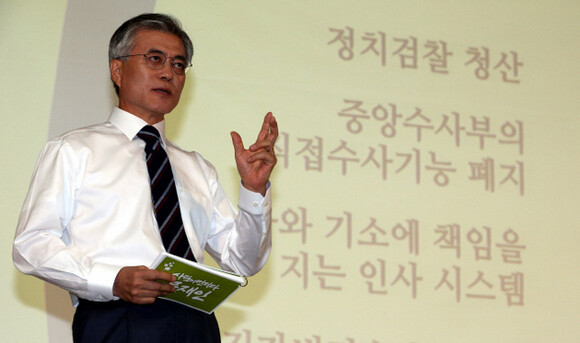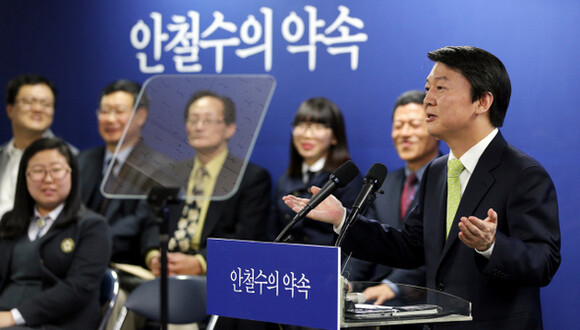hankyoreh
Links to other country sites 다른 나라 사이트 링크
Two liberal candidates have same goals but different methods


By Lee Tae-hee, staff reporter
Moon Jae-in and Ahn Cheol-soo’s policies have some things in common, but they are somewhat different. The election camp for Moon, the Democratic United Party presidential candidate, said they agreed on 95% of issues. Ahn’s camp said the policies generally overlapped, but diverged in key areas due to the candidates’ differing policy emphases.
In Moon’s case, those emphases are on big government and a stronger role for the public sector. Ahn agrees on the latter, but also stresses the role of the private sector, and particularly the social sphere.
These differences are most apparent in the chaebol reform measures in the two candidates’ economic democracy platforms. For circular equity investment, a method by which major shareholders increase affiliates with company money rather than their own, Moon wants break the cycle within the next three years, not just for new investment but also for existing investment frameworks. Ahn’s plan would only ban new investment, while adopting a wait-and-see approach on the results of chaebol reform before deciding on existing investments. Along the same lines, Ahn met with the Federation of Korean Industries and told members they would have to come up with their own reform plans.
Another difference is apparent in the candidates’ plans for growing SMEs. Moon’s focus is on increased corporate social responsibility through raw material/supply sharing and profit sharing. Ahn plans to provide tax and financial benefits until SMEs reach a certain level of development, even if they meet mid-term completion standards.
In terms of jobs, Moon wants to raise employment through public means, with all job creation effects reflected in government budgetary and policy support and tax benefits, while Ahn emphasizes cooperative, privately led social economy. Under Ahn’s approach, jobs and social services would be pushed simultaneously through cooperatives for each sector, including such areas as childcare, housing, and health care.
In the case of education policy, Moon’s plan for cutting tuition rates by half is to do it first at national and public universities in 2013 before extending it to private universities the following year. In other words, the former group gets priority treatment. Ahn is advocating lowering tuition at national, public, and private universities all at the same time, achieving tuition levels at half the current rates by the end of his term.
On the topic of university reform, Moon is pursuing a network linking national and public universities around the country, while Ahn is emphasizing increasing government involvement through expanded investment, which would extend even to private universities.
The two also differ in their approach to special purpose high schools, including foreign language and science high schools. Moon wants to incrementally convert all existing special purpose schools into ordinary high schools, while Ahn is more interested in getting rid of the priority selection of their students. Moon has also said he would do away with the system, phasing it out gradually to avoid an outcry. Ahn’s aim is to reap the effect of abolishing the system all at once by ending the special privilege of priority student selection rights.
Please direct questions or comments to [english@hani.co.kr]

Editorial・opinion
![[Column] Park Geun-hye déjà vu in Yoon Suk-yeol [Column] Park Geun-hye déjà vu in Yoon Suk-yeol](https://flexible.img.hani.co.kr/flexible/normal/500/300/imgdb/original/2024/0424/651713945113788.jpg) [Column] Park Geun-hye déjà vu in Yoon Suk-yeol
[Column] Park Geun-hye déjà vu in Yoon Suk-yeol![[Editorial] New weight of N. Korea’s nuclear threats makes dialogue all the more urgent [Editorial] New weight of N. Korea’s nuclear threats makes dialogue all the more urgent](https://flexible.img.hani.co.kr/flexible/normal/500/300/imgdb/original/2024/0424/7317139454662664.jpg) [Editorial] New weight of N. Korea’s nuclear threats makes dialogue all the more urgent
[Editorial] New weight of N. Korea’s nuclear threats makes dialogue all the more urgent- [Guest essay] The real reason Korea’s new right wants to dub Rhee a founding father
- [Column] ‘Choson’: Is it time we start referring to N. Korea in its own terms?
- [Editorial] Japan’s rewriting of history with Korea has gone too far
- [Column] The president’s questionable capacity for dialogue
- [Column] Are chaebol firms just pizza pies for families to divvy up as they please?
- [Column] Has Korea, too, crossed the Rubicon on China?
- [Correspondent’s column] In Japan’s alliance with US, echoes of its past alliances with UK
- [Editorial] Does Yoon think the Korean public is wrong?
Most viewed articles
- 1[Column] Park Geun-hye déjà vu in Yoon Suk-yeol
- 2Will NewJeans end up collateral damage in internal feud at K-pop juggernaut Hybe?
- 3N. Korean hackers breached 10 defense contractors in South for months, police say
- 4Thursday to mark start of resignations by senior doctors amid standoff with government
- 5[Guest essay] The real reason Korea’s new right wants to dub Rhee a founding father
- 6Kim Jong-un expressed ‘satisfaction’ with nuclear counterstrike drill directed at South
- 7Up-and-coming Indonesian group StarBe spills what it learned during K-pop training in Seoul
- 8Why Korea shouldn’t welcome Japan’s newly beefed up defense cooperation with US
- 9Opposition calls Yoon’s chief of staff appointment a ‘slap in the face’
- 10Terry Anderson, AP reporter who informed world of massacre in Gwangju, dies at 76